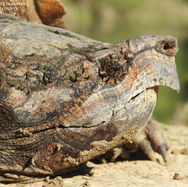
ALLIGATOR SNAPPING TURTLE (Macrochelys temminckii), (HARLAN, 1835)
IDENTIFICATION: 15-29 inches (38-71 cm). This is the largest species of freshwater turtle in the western hemisphere and some captive specimens have exceeded 250 pounds (113 kg). To date the largest known documented wild caught adult male from Texas weighed 211 pounds (95.7 kg). The largest female to date was captured in Tarrant County and weighed 70 pounds (31.7 kg). Mature females are distinguishable from males of similar size by having a cloaca opening that does not extend beyond the posterior margins of the carapace and a proportionately smaller head.
Unlike the common snapping turtle, Macrochelys has a short neck. The neck bears rows of fleshy tubercles and a large head with a curved beak. The carapace has three raised rows. Among old specimens the carapace is sometimes worn smoothly. There are 3-5 supra-marginal scutes along the bridge. The eyes are surrounded by a series of fleshy tubercles often creating the appearance of a star-like pattern and the iris has 6-7 radiating dark lines some of which contact the pupil. The interior of the mouth is drab, often matching the color of the flesh. On the end of the tongue is a small and bifurcated lure that can vary from drab tones of gray to bright pink. It twitches and writhes in a manner that entices fish into its mouth. No other living species of turtle possesses a predatory oral lure. However, like the common snapping turtle the plastron is reduced and cruciform in appearance. The basal coloration of the carapace is chestnut to drab brown. The head, neck, limbs, and tail are drab olive to dark tan. In older specimens the head tends to lighten in coloration ranging from yellow to ivory with a cream-colored spot near the tympanum.
GEOGRAPHIC DISTRIBUTION: The alligator snapping turtle occupies a geographic range that includes southwestern Georgia, northern Florida, Alabama, Mississippi, Louisiana, Arkansas, Texas, eastern Oklahoma, extreme southeastern Kansas, southwestern and eastern Illinois in the Mississippi Valley to Iowa and southwestern Kentucky. However, specimens may be difficult to locate in portions of their historic range as collecting, mortality from swallowing unattended baited lines, habitat loss and pollution have made a negative impact on many alligator snapping turtle populations. In Texas the alligator snapping turtle is found in the Trinity River from Tarrant County and river systems eastward.
BEHAVIOR AND ECOLOGY: Due to their size, fully grown adult alligator snapping turtles are mostly aquatic bottom dwellers. However, even large specimens have been observed basking on banksides and smaller specimens are sometimes seen basking amid tree branches. They have been found in a variety of habitats including lakes, oxbows, bayous, deep rivers, canals, creeks, ponds and even brackish estuaries. This species is an opportunistic feeder known to consume a wide variety of food items including but not limited to: acorns, briar roots, various aquatic plants, insects, crayfish, mollusks, fish, salamanders, frogs, turtles, snakes, birds and some known mammalian prey have included opossums, nutria, and mink. Despite its' varied diet, this turtle is best known for its ability to lure unsuspecting fish into its mouth. This is accomplished by holding the mouth agape and wriggling a lure in a manner similar to a convulsing and drowning worm. When the fish moves in for a closer inspection the mouth is slammed shut, water expelled through the nostrils and the fish is swallowed. Another feature possessed by this turtle is the re-curved cusp at the end of the beak. This characteristic is undoubtedly useful for securing struggling fish. In Texas, adult males have been seen surfacing for air after intervals of 18-23 minutes.
From March until May, Texas females can lay as many as 50 eggs per clutch. Incubation temperatures ranging from 20-25 degrees centigrade have resulted in incubation times of 79 to 107 days (Ernst, et al., 1994). The average incubation period for eggs hatched under captive conditions is approximately 100 days. Upon hatching, alligator snapping turtles average 38 mm in carapace length.
Illegal harvest for the black market meat trade in Louisiana and the use of unattended baited lines poses the biggest direct threat to this species in Texas. The illegal pet trade also poses a serious threat. The alligator snapping turtle is listed as threatened by Texas Parks and Wildlife and cannot be killed, possessed or taken without specific permits from Texas Parks and Wildlife.
































